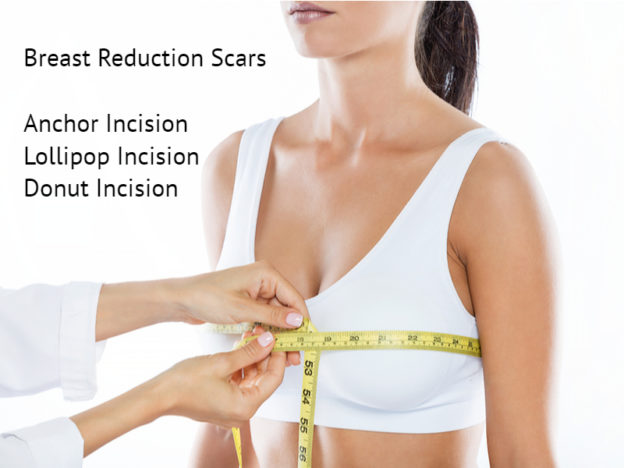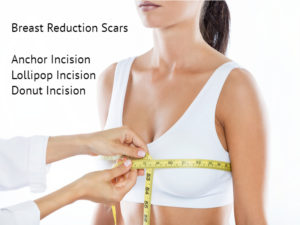If you’re thinking about having breast reduction surgery or have already had it done, you’re likely wondering about breast reduction scars. In this article, we will answer your questions related to breast reduction scarring and provide you with some tips to minimize scars.
Breast Reduction Scars: Basics
One worry that many people have when considering breast reduction surgery is having a noticeable scar. Whether or not you want breast reduction surgery for aesthetic, emotional, or physical reasons, you probably hoping to avoid any significant scarring.
Unfortunately, reduction of the breasts, even from a board-certified plastic surgeon, can involve some degree of scarring, as incisions into the breasts are required for the operation. What do the scars look like?
If you’ve had a surgical procedure before, like a tummy tuck, you probably know what a plastic surgery scar looks like: a red or pink thin line of raised skin. Over time, the color of the scar tissue will darken and flatten as the scar heals. The scars from a breast reductions incision site should begin to fade somewhere between several months to a year.
Also, if you have darker skin, you could be at a higher risk for hyperpigmentation, a condition associated with parts of the skin becoming darker than the rest of the surrounding skin, along with keloids or hypertrophic scars. A hypertrophic scar or keloid scar is a thick, raised scar caused by abnormal healing from a wound.
The size of the scar will depend largely on the type of technique used for the tissue removal procedure. These two techniques are called smaller-scar and larger-scar techniques. The large-scar technique involves three incisions on the breast, the smaller-scar technique involves only two incisions.
Also, due to the scar placement that runs along the bra line, the scars should not be visible in any outfits, including bikini tops and bras.
How does breast reduction work?
Breast reduction surgery is a cosmetic surgery procedure that removes excess breast glandular tissue, skin and fat to achieve a smaller breast size. Breast reduction surgery is also referred to as mammaplasty.
Can anyone receive the procedure?
Excessively large breasts can cause both physical and emotional issues for patients. Macromastia is a common problem for those with disproportionately sized breasts. Macromastia is associated with pain and other physical problems stemming from the large size of breasts, for example, back pain. Patients may also feel added emotional distress due to the size of their breasts and may desire a vertical breast reduction.
Breast reduction surgeries performed by board-certified plastic surgeons may also be used for breast lifts that reduce sagging.
What are the different techniques used?
There are two main breast reduction procedure techniques. The type of plastic surgery technique used will affect the size of the scar.
Shorter-scar technique
This technique involves two small incisions and is termed the circumvertical or lollipop incision. The first incision goes around the areola and the second goes from the bottom of the areola to the bra line. This is for smaller reductions like breast lifts.
Larger-scar technique
This breast tissue reduction technique involves three incisions. One incision is made between the areola and the breast crease. Another is made around the areola, and the final incision is made horizontally along the breast crease. This technique uses the inverted-T or anchor reduction.
How long does it take for the scars to close?
Listening to your doctor is an important part of letting your breast reduction scars close. You should continue wearing your chest bandages and surgical bra for the first few days after receiving the surgery.
It takes about a month for the incisions to fully close and heal, depending on several things, including genetic factors. Although everybody heals at different speeds, you can expect the incisions to be healed between three weeks and one month.
What are some post-op scar breast reduction procedures care tips?
- Follow the advice of your doctor and keep your bandages and surgical bra on for the allotted period of time to avoid skin irritation and infection.
- Try to limit your weight gain because gaining weight during recovery can widen the scar tissue.
- Reduce stress as this can impede your body’s ability to heal efficiently.
- Avoid smoking and tobacco products in general, as this impedes your body’s ability to heal.
- Avoid direct sunlight on your incision site scars and UV rays from tanning beds. UV light may cause the scars to darken.
Where are the scars from breast reduction?
Scars from breast reduction surgery from a cosmetic surgeon are along the breast crease or bra line, which is where your breast meets your chest. Incisions made along the breast crease make the scars barely visible as they are hidden along the bra line and horizontal. However, as mentioned above, the location of the scars depends on the type of technique used, but in general, the scars should be located below the nipple on the lower half of the breasts.
Thanks to the location of mammoplasty reduction scars, they should not be visible even in a bikini top or bra. However, the scarring might show along the bra line of breasts in minimal clothing with an anchor breast reduction. But for the most part, the scars should not be visible in any outfit.
Do breast reduction scars go away?
Although breast reduction scars will likely never completely go away, they should significantly fade to a thin, flat line, somewhere between a few months and a year after having the surgery. Furthermore, there are some ways that you can minimize breast reduction scars.
How can I minimize breast reduction scars?
There are several things you can do to minimize scars from having your breast reduced, including the below:
Scar massage: A scar massage involves gently massaging new scar tissue, horizontally, vertically, and in a circle with your fingertips. This may increase collagen, skin elasticity, and flexibility, as well as decrease discomfort.
According to the Moffitt Cancer Center, you can begin scar massaging after about two weeks post-surgery. Massage your scars for ten minutes every day up to three times a day.
Silicone sheets: Silicone sheets are bandages that have silicone in them. They help to hydrate the scarred area and make the skin more flexible.
Scar gels: Scar gels are another topical solution, like silicone strips. that may help to minimize scarring from this type of surgical technique. They can be used for fresh or older scars to minimize the appearance of scars, allowing the color to fade and the size of the scar to shrink.
Ask your doctor if you are interested in using scar gels, they may advise you to apply a scar gel as soon as the incision heals, and may recommend supplementing with vitamin e or chemical peels. However, to be effective they must be used every day until the scar fades, which can take several months.
Surgical tape: After your mammoplasty, your doctor will likely recommend that you use surgical tape for the first two weeks of the healing process. Surgical tape applied on the scars will help to keep the incision closed so that it can better heal.
Dressings: Like surgical tape, embrace dressings help to pull the skin together to keep the incision closed in order to stimulate proper healing. They can be used for up to a year after surgery and may include silicone to keep the scarred area hydrated and the skin flexible.
Steri-strips: Steri-strips can be used for two weeks to a month after surgery. They are permeable strips that keep the incision closed to allow the medicine to go through while helping the incision to heal properly.
Supportive bras: Wearing a high-quality and supportive bra is essential after breast reduction surgery. They should be worn 24 hours every day for six weeks after surgery. Wearing a supportive bra can reduce scarring and help the healing process after surgery.
Fractionated lasers: Fractionated lasers may be used as a treatment option after the scars have completely healed to minimize the appearance of the scars. These microscopic lasers can target the top and middle layers of the skin and scars.
Sunscreen: As mentioned, exposure to sunlight and UV rays can cause your scars to darken in color. Even if your breasts are not in direct sunlight, UV light from the sun may still affect them. Therefore, apply a broad-spectrum sunscreen with a minimum SPF of 30, according to the American Academy of Dermatology Association.
Scar Revision Surgery: If you are still unsatisfied with your scars after they have faded, you can opt to have scar revision surgery. Depending on how well your scars heal or how much they bother you, this may be an attractive option.
However, it is important to note that even this procedure will not completely remove your scars. In contrast, they will further reduce your scars, replacing them with smaller, thinner, and shallower ones.
Steroid Injections: Steroids injections may be a good option for people who have thick, raised scars years after the surgery and want to reduce their size and appearance. This procedure helps to soften the scar tissue and reduce its size.
Is there scarless breast reduction?
Yes, there is scarless breast reduction, it is referred to as liposuction breast reduction. It involves two very small surgical incisions into each breast that is practically invisible once healed. Its use is limited in that surgeons can only remove fatty breast tissue with lipo, not glandular tissue. Still, liposuction for breasts can finely contour the breasts, and can have beautiful results when combined with traditional breast surgery.
Find a Specialist to Help Treat Breast Reduction Scars in Your Area
Whether you want to reduce the size of your breasts or get a breast lift to reduce sagging, if you plan on getting a mammoplasty or are interested in the idea, you should speak with a plastic surgery doctor. They can help you to find a top-notch breast reduction surgeon near you.
It is important to go with a well-qualified, high-quality plastic surgery specialist so that you can be assured the procedure will go well and you will have minimal scarring. Start your search for a highly qualified 5-star plastic surgeon with the SurgeonNetwork.com directory, where you can search by city and specialty.




